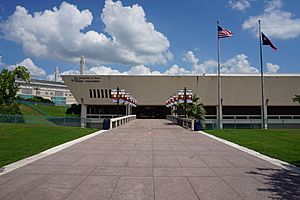Institute of Texan Cultures facts for kids
 |
|
| Established | 1968 |
|---|---|
| Location | San Antonio, Texas |
The Institute of Texan Cultures (also called The ITC) is a special museum and library that is part of The University of Texas at San Antonio. The building where the museum was located was known for its strong, simple design style called Brutalist architecture. It was added to the National Register of Historic Places in 2024, recognizing its importance.
The ITC was Texas's main place for learning about different cultures. It offered exhibits, programs, and events like the Texas Folklife Festival. This festival is a yearly celebration of the many different groups of people who live in Texas. The festival has been held every year since 1972.
Contents
History of the Institute
The Texas Legislature created the Institute of Texan Cultures on May 27, 1965. The building first served as the Texas Pavilion during HemisFair '68, a big world's fair held in San Antonio. After the fair, in 1969, the building was given to the University of Texas System.
The University of Texas at San Antonio (UTSA) took over running the museum in 1973. Later, in 1986, the system officially made the institute a campus of UTSA. This showed how important the museum was to the university.
What the ITC Offered
The ITC helped people understand and appreciate Texas and its people through its research, collections, and exhibits. The large complex was about 182,000 square feet. It had 65,000 square feet of interactive exhibits and displays for visitors.
The library on the third floor was a treasure trove of history. It held old manuscripts, rare books, and personal papers. There were also over 3 million historical photos and more than 700 oral histories. These were recordings of people sharing their life stories.
How the Museum Was Funded
The museum received money from a few main sources. The Texas Legislature provided funds every two years. The museum also earned money from tickets to its exhibits and special events. Grants, donations, and other local funds helped too.
These local funds came from renting out the museum's spaces. They also came from selling publications, videos, library services, and items from The Museum Store. A group called the Development Board gave major support. In 2011, the Texas Legislature cut funding by 25%. This meant the institute had to rely more on private donations and company sponsorships.
Learning About Texas Cultures
The ITC worked hard to be the state's center for multicultural education. It researched the history of different ethnic and cultural groups in Texas. Then, it shared this information in many ways:
- Exhibits, programs, and special events that were fun and educational.
- A library focused on the history of different cultures.
- A collection of over 3.5 million historical photos.
- An outreach program that visited schools and other groups.
- Workshops to help teachers learn more about Texas history.
The museum had displays showing many cultures. These displays highlighted how different groups impacted Texas's history and growth.
Smithsonian Partnership
In early 2010, the institute became a partner with the Smithsonian Affiliates program. This partnership gave the ITC access to the Smithsonian's amazing artifacts. It also provided educational programs, expert speakers, and workshops for teachers.
This agreement helped the institute improve its exhibitions. As UTSA aimed to become a top research university, its museum also worked to become a leading cultural place.
Future of the Institute
On April 3, 2024, UTSA announced that the museum would close its doors on May 31, 2024. The building that housed the ITC was planned for demolition. The museum was set to reopen in early 2025 at a temporary spot. This temporary location was on the first floor of the Frost Bank Tower.
At the time of the announcement, a permanent home for the museum had not been chosen. The temporary location was expected to operate until 2030. By then, a permanent museum would be selected, built, and ready to open. Some possible locations for the permanent museum included property at the UTSA Southwest Campus. Another idea was a parking lot near The Crockett Hotel, close to The Alamo. Demolition of the old building started on April 8, 2025, even with some efforts to stop it.
See also
- List of museums in Central Texas
- Caudill Rowlett Scott (CRS)
- Texans All - A series of books about Texans

